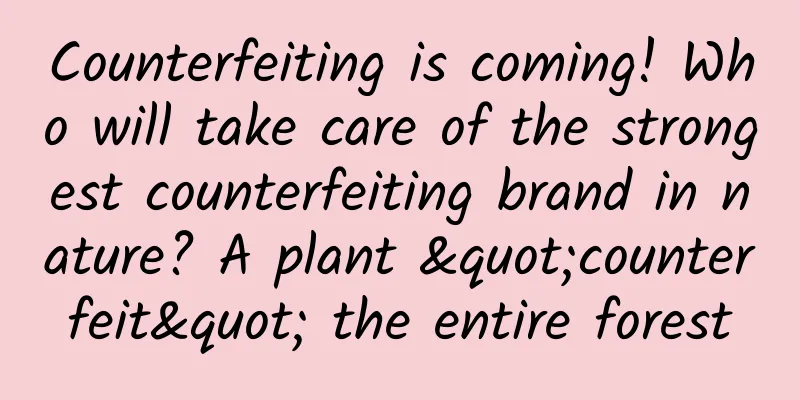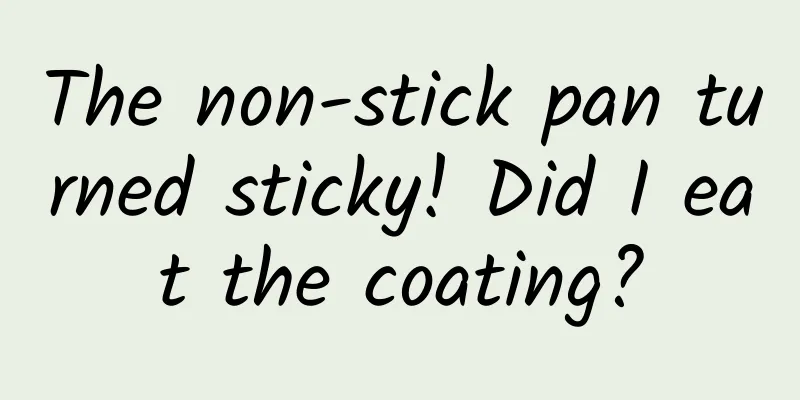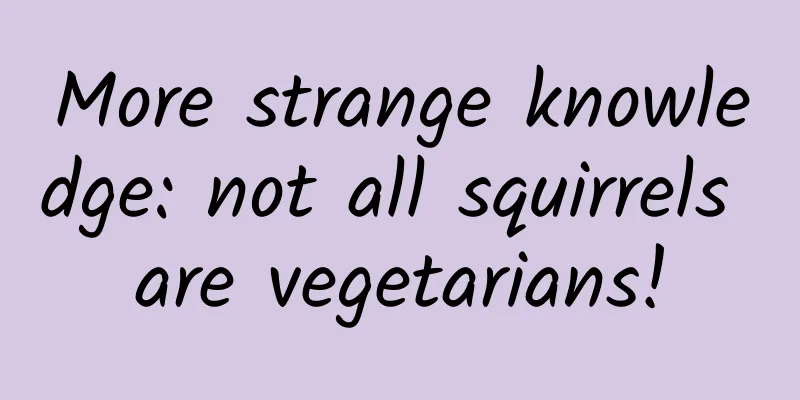Counterfeiting is coming! Who will take care of the strongest counterfeiting brand in nature? A plant "counterfeit" the entire forest

|
Produced by: Science Popularization China Author: Liao Xinfeng Producer: China Science Expo Just like in human society, this phenomenon also exists in nature: where there are genuine products, there are also fakes. Plants may not seem to have any "minds", but their fakery is also too numerous to mention. The reason why plants are being faked is similar to the phenomenon of fakes in our human society. Because the competitiveness of the "real thing" is strong enough, there is no need for later innovations in the cruel nature, the cost is too high. It is better to make a fake that looks like the "real thing", which is low cost and high profit. The flowers, leaves and seeds of the plants we see all have falsification phenomena. Let’s look at the flowers first. "Fake flowers": blooming next to the real ones, it's always a mistake to see them The most faked plant is flowers. Because most flowers need to attract animals to pollinate, but attracting pollinating animals requires providing "rewards" - pollen or nectar, so some plants have evolved a way to "cheat". They do not produce such "rewards", but bloom next to flowers with "rewards", and their appearance is consistent with that of flowers with "rewards". This phenomenon is called Batesian mimicry. Batesian mimicry refers to a phenomenon in which an organism imitates another organism in some characteristics to deceive it into defending or attracting another organism. Batesian mimicry is very common in the animal kingdom. For example, some caterpillars we often see have spots on their bodies that resemble snake eyes. When predators such as birds look at them, they think they are snakes and are scared away. But scientists have discovered that this phenomenon is more common in plants than we thought, and the most typical example is the flowers of a plant called Disa pulchra that lives in South Africa. Let's take a look at the two flowers below. If you only look at the flowers, it may be hard to imagine that these are actually two completely different and distantly related plants. Image source: Reference [1] On the left is the real one, Watsonia lepida, a member of the genus Watsonia in the family Iridaceae. On the right is its "high imitation" - Disa pulchra, a member of the genus Disa in the family Orchidaceae. The contrast is more obvious. The left one is Trumpet orchid, and the right one is Disa pulchra. (Image source: Reference [1]) The two flowers are very similar in overall appearance, color, size, and number. Early botanists even confused these two plants from completely different families. Especially when the habitats of the two plants overlap, it is difficult for botanists to distinguish them at a glance in the wild. Scientists' observations of the insects that visit the flowers of the two plants in the wild also confirmed that plants can "fake". The main pollinators of the two plants are the same, and there are also cases where the insects visit the two flowers alternately. This fully proves that the "fake flowers" are real enough to deceive their targets. The purpose of "fake flowers" is now very obvious - through "fake flowers", flowers obtain pollination services at a low cost. "Fake Fruit": You have nutrition, I have time Similar counterfeiting behavior exists in fruits and seeds as in flowers, and most of the time seeds are used to simulate fruits, which can be considered very "courageous". Most of the people deceived by these plants are birds. For example, the common Echinops plants have bright seeds, which are mostly red and look like bright fruits. The red color is also very eye-catching to birds. Most legumes spread their seeds by twisting the pods open (yes, they twist themselves) and dropping the seeds, spreading them. Legumes generally disperse their seeds by twisting their pods. (Image source: Reference [2]) The seeds of the red bean family are different. They are disguised as fruits to lure greedy birds to take the bait and spread the seeds. After their pods crack, the seeds still lie or hang inside the pods, with the hilum attached to the pods. The red seeds hang on the tree like this, standing out against the brown pods, just like individual fruits. Do the hanging red bean seeds look like fruits? (Image source: Flickr) But they have no fleshy parts for birds to eat, and their seeds are hard and poisonous. It seems that they are essentially just pretending to be fruits. Anatomy of the fruit of the genus Echinops (Image source: Reference [3]) However, this simulation is risky. After being fooled again and again, birds may learn that these seeds are not fruits and have no digestible nutrients, and thus give up eating them. In the wild, the probability of red bean seeds being eaten is actually not high. However, the lack of fleshy parts around the seeds also allows them to stay "fresh" longer in the air, and the "fruit-hanging" time will be longer. In such a long period of time, even if only occasionally tricking birds to spread, it is a worthwhile business. Isn't the essence of counterfeiting to bet small for big? They know how to gamble. "Fake Leaf": When I get close to you, I become you Of course, if you want to talk about the strongest "fake" in the plant world, I think it has to be Boquila trifoliolata. This is a woody vine found in the temperate rainforests of South America. It has raised the plant's "counterfeiting" ability to an incredible level. It can fake at least 12 host trees with just one vine. It can be said to be "low investment, high return"! The chamomile is a member of the Akebia family, and is a member of the same family as the wild fruit "August Explosion" that we have eaten. The leaves of the chamomile are also the same as theirs, with a single leaf being a compound leaf composed of three lobes. The original appearance of the leaves of the chameleon (Image source: Wikipedia) But once it climbs onto a host, its leaves will undergo tremendous changes, and be reshaped like the host's leaves. Sun Wukong has 72 transformations, and it has 12. This is very magical. It is easy to understand if one is forged, but the leaves of each host are different, which fully reflects the saying "no two leaves are the same". But the "faking" ability of the chameleon is so superb. Scientists used 11 leaf traits to compare the similarity between the chameleon and the host, and found that the two were very similar in 9 traits such as leaf angle, leaf size, petiole length and leaf color. It can be said that the chameleon has achieved a complete simulation in all dimensions of the leaves, mixed in with the host leaves, to the point where it is difficult to distinguish the real from the fake at a glance. Chamaecyparis chamaecyparis (V) and the different hosts they mimic (T) (Image source: Reference [4]) What’s even more interesting is that the same chamaeleon can even mimic different hosts when it shuttles between different hosts. So far, we are still not sure where the limit of its fakery is. Perhaps it is a kaleidoscope of fakery in the plant world. A chamaecyparis mimics the leaves of different hosts. (Image source: Reference [4]) The chameleon has used all its tricks and mastered the technology of counterfeiting. What is its purpose? Scientists have found that by "faking it", the chameleon can reduce the risk of being preyed on. Compared with individuals that are not attached to a host or are not mimicking, individuals that are integrated with the host's leaves have a significantly lower risk of being preyed on. Because the density of the chameleon's leaves is generally lower than that of the host, by "faking it" and integrating into the host, even if the host is preyed on, the host is still at greater risk. Statistics on the predation intensity of different Chamaecyparis chamaejas individuals when they were attached to a host, not attached to a host, and attached to a leafless tree trunk (Image source: Reference [4]) Conclusion After reading about the "fake" path of plants, do you no longer believe that plants are "honest people"? Whether it is the "fake" of flowers, leaves or seeds, they use this trick to reduce their own input costs and greatly increase the possibility of survival in nature. But we need to remind everyone that the laws of nature can be "barbaric", as long as "faking" can gain survival advantages, everything will be judged and screened by natural selection. But human society is built by ourselves, and in order to maintain the normal operation of the market, we should also abide by the rules, and we dare not learn from nature to cheat. References: [1] Janzen, Daniel H., Winnie Hallwachs, and John M. Burns. "A tropical horde of counterfeit predator eyes." Proceedings of the National Academy of Sciences 107.26 (2010): 11659-11665. [2] Armon, Shahaf, Efrati, et al. Geometry and Mechanics in the Opening of Chiral Seed Pods.[J]. Science, 2011. [3] Peres, C. A, Roosmalen V, et al. Avian dispersal of "mimetic seeds" of Ormosia lignivalvis by terrestrial granivores: deception or mutualism?[J]. Oikos, 1996. [4] Gianoli, Carrasco-Urra. Leaf Mimicry in a Climbing Plant Protects against Herbivory[J]. CURR BIOL, 2014, 2014,24(9)(-):984-987. Editor: Guo Yaxin (Note: Latin text should be italicized.) |
>>: China to launch Einstein probe to explore ever-changing universe
Recommend
After testing hundreds of pieces, many families still use these high-risk products
"Dad's Laboratory" has been providi...
Alipay APP changes its icon: 2021 "Collect Five Blessings" is here, with more ways to play this year
There is less than a month left until the 2021 Sp...
Nanchong SEO training: How to identify the quality of website articles
For website optimization, both the inside and out...
It took only 6 years for mobile advertising to defeat PC and become the protagonist of digital advertising. What happened in the advertising market?
Seven years ago, Apple iPhone 4 was released and ...
Why do some landing pages make you want to buy after seeing them?
What’s changing in digital advertising ? What is ...
Xinyou Internet CEO: Creating an ideal connector for multi-screen entertainment
Recently, a piece of news in the gaming industry ...
How to quickly find mini programs in WeChat?
On January 9, 2017, WeChat Mini Programs were off...
Top Growth Hackers: How to Use Data Experimentation to Build a Growth Engine
Growth hackers are the real source of revenue for...
If you don't know these iOS tricks after getting an iPhone, then you've wasted your money
Some friends buy an iPhone but still don’t know w...
Let’s talk about the rise and fall of Skype
Skype, the voice, video and instant messaging app...
When operating an event, how can we ensure that attracting new users is valuable?
Mastering how to organize activities is one of th...
Taobao Live: 90% of brands’ large-scale self-entertainment live pictures!
Weibo in 2015, WeChat in 2016, Xiaohongshu in 201...
Exchange cooperation tutorial: Things you don’t know about exchange
1. The significance of volume exchange cooperatio...
You are not allowed to eat porridge for breakfast? What is the problem with porridge? How to eat it healthily
Recently, a video of Dr. Zhang Wenhong has caused...
Google's 20 rules for developers
[[133902]] For developers, everyone hopes that th...









